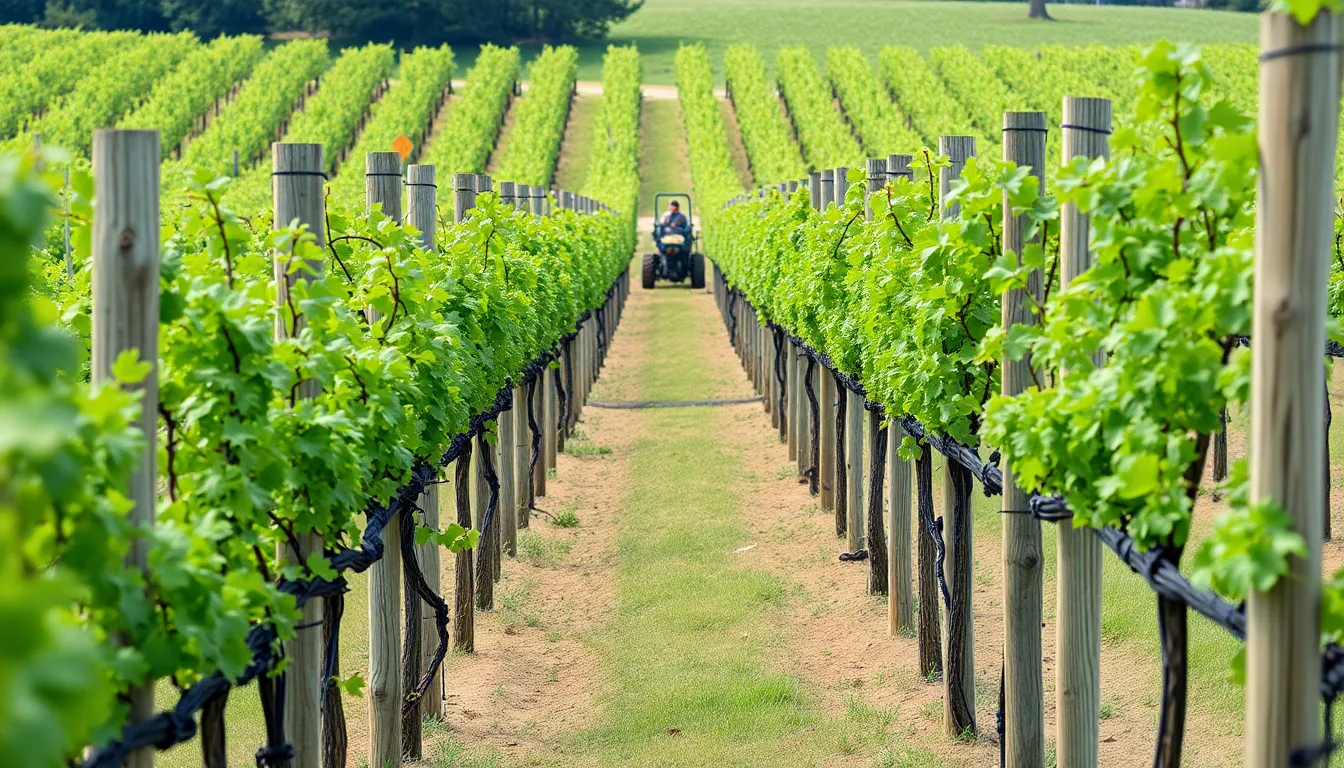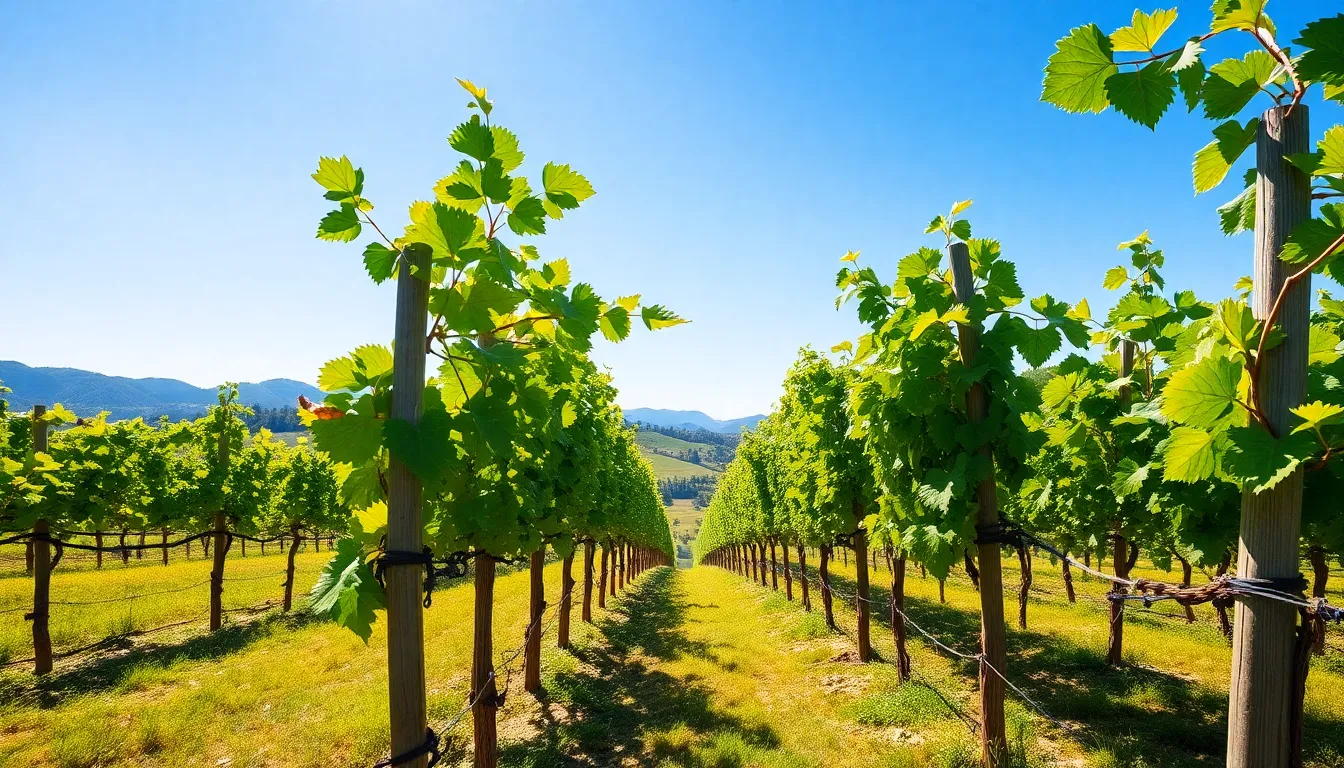Growing grapes successfully starts with one crucial decision: choosing the right trellis system. We’ve seen countless grape growers struggle with poor harvests and diseased vines simply because they didn’t invest in proper support structures from the beginning.
A well-designed grape vine trellis isn’t just about keeping your vines upright – it’s the foundation of your entire vineyard’s success. The right trellis system maximizes sun exposure, improves air circulation, and makes harvesting significantly easier. Whether you’re planning a small backyard vineyard or managing acres of grapes, understanding trellis options can mean the difference between mediocre fruit and premium-quality grapes.
We’ll walk you through everything you need to know about grape vine trellises, from selecting the perfect system for your space to installation tips that’ll save you time and money. By the end, you’ll have the knowledge to create a support system that helps your grape vines thrive for decades to come.
Choose the Right Grape Vine Trellis System for Your Vineyard
Selecting the appropriate trellis system determines how effectively your grape vines will develop and produce fruit throughout their growing seasons. Each training method offers distinct advantages depending on your vineyard’s exact conditions and grape varieties.
High Cordon Training System
High cordon systems position the main vine trunk at 5 to 6 feet above ground level. We recommend this approach for wine grape varieties like Cabernet Sauvignon and Chardonnay that benefit from elevated canopy management. The elevated cordons create excellent air circulation around grape clusters while reducing ground moisture contact that can lead to fungal diseases.
Installation requires sturdy posts spaced 20 to 24 feet apart with horizontal wires at the cordon height. Metal T-posts or wooden posts work effectively for supporting the wire tension needed for mature vines. You’ll need catch wires positioned 12 to 18 inches above the cordon wire to support the growing shoots as they develop upward.
Maintenance becomes easier with high cordon systems since pruning and harvesting occur at comfortable working heights. Workers can access grape clusters without excessive bending or crouching that’s required with lower training systems. This positioning also allows mechanical harvesters to operate efficiently in larger vineyard operations.
Low Cordon Training System
Low cordon training positions the permanent vine structure 2 to 3 feet above ground level. This system works particularly well for table grape varieties and regions with strong winds that might damage higher canopies. The lower profile provides natural protection from wind damage while maintaining good sun exposure for grape development.
Construction costs are typically 20 to 30 percent lower than high cordon systems due to shorter posts and reduced wire requirements. Standard fence posts at 4 to 5 feet in height provide adequate support for the cordon wire and catch wires. You can space posts 16 to 20 feet apart depending on your soil conditions and expected vine load.
Harvest efficiency varies with low cordon systems since workers must bend more frequently to reach grape clusters. But, this training method allows for easier winter protection in cold climates where you might need to cover vines or bury cordons. The system also works well for smaller vineyard operations where hand harvesting remains the primary collection method.
Vertical Shoot Positioning System
Vertical shoot positioning (VSP) trains grape vine shoots to grow straight upward between parallel wires. We use this system extensively for premium wine grapes because it maximizes leaf exposure to sunlight while creating uniform canopy density. The vertical orientation allows for precise canopy management that directly impacts grape quality and ripening consistency.
Wire configuration includes a fruiting wire at 30 to 36 inches with catch wires positioned every 12 inches above that point. Most VSP systems use 3 to 4 sets of catch wires extending to heights of 6 to 7 feet total. The parallel wires create channels that guide shoot growth while providing support during heavy fruit loads and wind events.
Canopy management requires regular shoot positioning throughout the growing season to maintain the vertical orientation. You’ll need to tuck new shoots between the catch wires every 2 to 3 weeks during active growth periods. This hands-on approach allows for better pest and disease monitoring while ensuring optimal light penetration to grape clusters for even ripening.
Plan Your Grape Vine Trellis Layout and Spacing

Now that we’ve explored different trellis systems, we need to focus on the critical foundation of proper layout and spacing. Strategic planning of your vineyard’s physical dimensions directly impacts vine health, maintenance efficiency, and long-term productivity.
Determining Row Spacing Requirements
Row orientation should maximize sunlight exposure throughout the day while promoting optimal air circulation between vine rows. We recommend orienting rows to capture morning sun and prevent moisture buildup that leads to fungal diseases.
Spacing between rows varies significantly based on your chosen grape cultivar and the maintenance equipment you’ll use. Table grape varieties typically require wider spacing than wine grapes due to their larger canopy spread and different pruning requirements.
Equipment considerations play a crucial role in determining row width. Tractors, sprayers, and harvesting equipment need adequate clearance to operate efficiently without damaging vines or compacting soil around root zones.
Cultivar exact needs influence row spacing decisions. Vigorous varieties like Concord grapes need more space between rows compared to compact wine grape varieties such as Pinot Noir or Riesling.
Calculating Post Intervals and Distances
Post spacing should range between 5 to 8 feet apart to provide adequate support for mature vine weight while maintaining proper wire tension. This spacing accommodates most grape varieties without creating excessive installation costs.
Hole depth requires digging approximately 1.5 feet deep to ensure post stability in various soil conditions. Sandy soils may need deeper installation while clay soils often provide sufficient support at standard depths.
Weight distribution depends on proper post intervals to prevent wire sagging under the load of fully developed grape clusters. Posts spaced too far apart create stress points that can damage your trellis system during heavy fruit loads.
Wire tension maintenance becomes easier with consistent post spacing throughout your vineyard. Regular intervals allow for uniform tension adjustments and simplify replacement of damaged sections.
Planning for Equipment Access
Maintenance pathways require sufficient width between rows for pruning equipment, ladders, and personnel to move freely during seasonal vineyard tasks. We recommend measuring your largest equipment piece and adding at least 2 feet of clearance on each side.
Harvesting accessibility needs consideration for both manual and mechanical harvesting methods. Hand harvesting requires comfortable working space while mechanical harvesters need precise row width specifications to operate effectively.
Spray equipment clearance demands adequate row spacing for pesticide and fertilizer application equipment to reach all vine surfaces without damaging branches or fruit clusters. Insufficient spacing leads to poor coverage and potential crop loss.
Post height planning should position horizontal wires at easily accessible heights for vine training and maintenance. Wires spaced approximately 1.5 feet apart provide optimal access for most grape training systems while supporting proper vine development.
Select Durable Materials for Your Grape Vine Trellis

Choosing the right materials forms the backbone of any successful grape vine trellis system. We’ll explore three primary material options that vineyard professionals rely on for long-term performance.
Wooden Posts and Their Longevity
Wooden posts provide a natural aesthetic that many vineyard owners prefer for their grape vine trellis installations. Pressure-treated wood and cedar varieties offer extended lifespans compared to untreated lumber, with cedar naturally resisting rot and insect damage. These materials typically serve effectively for 10 to 15 years before requiring replacement, depending on environmental conditions and treatment quality.
Various lengths and diameters accommodate different trellis heights and vine loads. Treatment options include chemical pressure treatments that penetrate deep into the wood fibers, significantly extending usable life. Environmental factors like soil moisture, temperature fluctuations, and regional climate patterns directly impact wooden post durability.
Regular inspection helps identify early signs of deterioration such as surface cracking, soft spots, or pest damage. We recommend checking wooden posts annually to ensure continued structural integrity for your grape vine support system.
Metal Posts and Wire Options
Metal posts deliver superior durability that justifies their higher initial investment for grape vine trellis systems. Steel posts frequently last 25 years or more with proper maintenance, nearly doubling the lifespan of wooden alternatives. Installation proves easier due to their lighter weight and consistent dimensions, reducing labor costs during vineyard establishment.
Reusability becomes a important advantage when vineyard replanting occurs, as steel posts maintain structural integrity through multiple growing cycles. High-tensile galvanized steel wires complement metal posts perfectly, offering exceptional strength and corrosion resistance for wire support systems.
Galvanized coatings protect against rust and environmental damage, ensuring long-term performance in various weather conditions. We’ve observed that metal post systems require minimal maintenance compared to wooden alternatives, primarily needing periodic wire tension adjustments and coating inspections.
Concrete Posts for Permanent Installations
Concrete posts represent the most permanent solution for grape vine trellis construction, though they’re less commonly used than wood or metal options. Exceptional durability characterizes concrete installations, as they withstand environmental stresses better than traditional materials without requiring regular replacement cycles.
High upfront costs present the primary barrier to concrete post adoption, often requiring important initial investment for vineyard development. Installation difficulty increases substantially compared to wooden or metal posts, typically requiring specialized equipment and experienced installation crews.
Permanent nature makes concrete posts ideal for established vineyards with long-term production goals spanning decades. We recommend concrete installations primarily for commercial operations where initial investment costs can be amortized over extended production periods, ensuring maximum return on trellis infrastructure investment.
Install Your Grape Vine Trellis Foundation Properly

Now that we’ve selected our materials, we’ll focus on building a rock-solid foundation that’ll support our grape vines for decades. A properly installed trellis foundation withstands environmental forces and maintains wire tension throughout the vineyard’s productive life.
Setting End Posts and Anchors
End posts serve as the backbone of our entire trellis system since they bear the tension from all trellis wires and support the complete row of vines. We must anchor these posts securely because they experience the greatest stress from wire tension and environmental factors.
For vineyard rows shorter than 600 feet, we anchor end posts using earth anchors, tie-back posts, or deadmen systems. Longer rows require enhanced stability through H-braces or slant braces that distribute the load more effectively across multiple support points.
We dig post holes approximately 2 feet deep and 12 inches in diameter to provide adequate space for concrete or compacted soil anchoring. This dimension ensures our end posts remain stable under maximum tension loads and resist frost heaving during winter months.
Installing Line Posts at Correct Depths
Line posts create the intermediate support structure between our end posts and maintain proper wire positioning throughout each vineyard row. We space these posts 21 to 28 feet apart depending on our vine spacing requirements and exact vineyard row design.
Proper depth installation prevents post movement under wire tension and environmental stresses like strong winds. We set line posts at least 2 feet deep to achieve adequate holding power while considering soil conditions and frost line depths in our region.
Our line posts support trellis wires at exact heights with lower wires positioned 36 to 40 inches above ground and upper wires placed 60 to 72 inches high. These measurements accommodate various vine training systems while ensuring optimal grape cluster positioning for sunlight exposure and air circulation.
Ensuring Proper Post Alignment
Precise post alignment creates uniform wire tension across our entire vineyard and facilitates efficient maintenance operations throughout the growing season. Proper alignment also enables smooth equipment movement during cultivation, spraying, and harvesting activities.
We use string lines or laser levels during installation to maintain straight rows and consistent post spacing. This careful measurement prevents wire sagging and ensures each vine receives equal support as it develops its mature canopy structure.
After setting all posts correctly, we attach galvanized high-tensile steel wires that provide the framework for training our vines according to our chosen system. Whether we carry out high cordon, vertical shoot positioning, or Geneva double curtain training, properly aligned posts ensure optimal wire performance and vine development over our vineyard’s 20+ year productive lifespan.
String and Tension Your Grape Vine Trellis Wires

We’ll now focus on the wire installation process that transforms your post foundation into a functional grape vine support system. Proper wire selection and tensioning creates the structural backbone that’ll support your vines for decades.
Choosing the Right Wire Gauge
High tensile galvanized steel wire provides the durability and strength essential for long term grape vine support. No. 9 or 10 gauge wire represents the industry standard for grape vine trellises due to its optimal balance of strength and flexibility. Galvanized coating protects the steel core from rust and corrosion, extending wire life significantly in outdoor vineyard conditions.
Wire gauge selection directly impacts your trellis performance over time. No. 9 gauge wire offers maximum strength for heavy bearing vines and windy locations, while No. 10 gauge provides adequate support for lighter vine loads at a lower cost. We recommend No. 9 gauge for commercial vineyards and heavy producing varieties like Concord or Muscadine grapes.
Steel composition matters as much as gauge when selecting trellis wire. High tensile steel maintains its strength under constant load and weather exposure, unlike standard fence wire that stretches and weakens over time. This superior material choice prevents wire sagging and reduces maintenance requirements throughout your vineyard’s productive life.
Creating Proper Wire Tension
Turnbuckles provide the adjustable tension control needed for optimal wire performance. These mechanical devices allow us to fine tune wire tension after installation and make seasonal adjustments as needed. Proper tension enables wires to move slightly with wind and vine growth rather than breaking under stress.
Wire tension must balance support strength with flexible movement. Over tensioned wires snap during high winds or sudden vine loads, while loose wires fail to support grape clusters adequately. We target tension that produces a slight vibration when plucked, similar to a guitar string but much less tight.
Seasonal tension adjustments account for temperature changes and vine growth. Cold weather contracts metal wires and increases tension, while hot weather causes expansion and loosening. Regular tension checks during spring and fall help maintain optimal wire performance throughout the growing season.
Installing Catch Wires and Support Systems
Catch wires support lateral vine growth in complex trellis systems like the Geneva Double Curtain. These secondary wires run perpendicular to main support wires, creating a network that guides horizontal shoot development. Complex systems benefit from catch wire installation to maximize fruiting wood support and improve grape cluster positioning.
Inline posts spaced 20 to 25 feet apart provide adequate support for simple trellis designs. This spacing balances material costs with structural integrity for most grape varieties and growing conditions. Closer spacing of 5 feet works better for smaller trellises supporting heavy vine loads or in high wind areas.
Bracing systems like H braces or slant braces strengthen longer vineyard rows. These structural elements prevent end post movement and maintain wire tension across extended distances. We install bracing systems every 300 to 500 feet in commercial vineyards to ensure consistent wire support throughout the entire row length.
Train Young Grape Vines on Your Trellis System

Once you’ve built your trellis foundation, the next crucial step involves training young grape vines to establish their structure and maximize their potential. We’ll guide you through each stage of development to ensure your vines develop into productive, well-structured plants.
First Year Vine Training Techniques
Select the strongest shoot from your newly planted vine and secure it vertically to a garden stake or directly to the trellis wire. The main goal during this first year focuses on developing a single, sturdy trunk that will serve as the foundation for all future growth.
Tie the chosen shoot at regular intervals using soft materials like plant ties or strips of cloth to avoid damaging the tender bark. We recommend checking these ties monthly and loosening them as the vine grows to prevent girdling.
Remove competing shoots and lateral growth below your desired trunk height to concentrate the vine’s energy into developing one strong main stem. This selective pruning approach prevents the vine from dividing its resources among multiple weak shoots.
Maintain minimal pruning during this establishment year to avoid stressing the young plant. Focus only on removing shoots that grow downward or compete directly with your selected main trunk.
Second Year Canopy Development
Allow the main trunk to reach your desired height of 4 to 6 feet, typically stopping it just below the top trellis wire. At this stage, we begin shaping the vine’s permanent fruiting structure.
Select 2 to 4 strong shoots near the top of the trunk to form the horizontal cordons or arms that will extend along your trellis wires. These cordons become the framework that supports all future fruit production.
Train these cordon shoots horizontally along the trellis wires, tying them securely at 12 to 18 inch intervals. We position these arms to create balanced growth on both sides of the main trunk.
Prune lateral shoots on the developing cordons to maintain proper spacing and ensure adequate air circulation through the canopy. This management prevents overcrowding and reduces disease pressure.
Balance leaf coverage with airflow by removing excess foliage that blocks sunlight penetration or restricts air movement through the vine structure. Proper canopy management during year two sets the stage for healthy fruit production.
Establishing Permanent Vine Structure
Complete the permanent structure by the end of the second or third year, choosing between common training systems like the four cane single trunk Kniffin system or the bilateral high cordon system. Your choice depends on your grape variety and climate conditions.
Secure the horizontal cordons permanently along the trellis wires, ensuring they’re positioned to support the vine’s weight throughout its productive life. These cordons will carry the fruiting spurs or canes for decades to come.
Establish annual pruning routines to maintain the vine’s shape and encourage consistent fruit production. We remove old wood while preserving young, productive canes that will bear the current season’s crop.
Support the mature canopy with your trellis system, which now bears the full weight of leaves, fruit, and woody structure. Regular maintenance of both vine and trellis ensures healthy growth and simplifies harvest operations.
Monitor vine development continuously, making adjustments to training techniques as your exact varieties and growing conditions dictate. This ongoing attention to vine structure pays dividends in fruit quality and vineyard longevity.
Maintain Your Grape Vine Trellis Throughout the Seasons

Once we’ve established our trellis system and trained our vines, ongoing maintenance becomes crucial for long-term vineyard success. Proper seasonal care ensures our grape vine trellis remains structurally sound while supporting healthy vine development year after year.
Annual Wire Inspection and Replacement
Checking our trellis wires annually prevents catastrophic failures that could damage entire vine sections. We should examine each wire for signs of corrosion, stretching, or breakage that occurs naturally from weather exposure and vine tension.
Galvanized wire offers superior longevity compared to standard wire options, lasting up to 15 years in most climates. High tensile wire provides even greater durability for commercial operations where replacement costs significantly impact profitability.
Replacing worn wires before they fail protects our investment in mature vines. We must tension new wires properly to prevent sagging while avoiding over-tightening that could snap under seasonal temperature changes.
Post Maintenance and Repair
Inspecting our posts regularly identifies structural weaknesses before they compromise vine support. Wooden posts require particular attention around the soil line where moisture and insects cause the fastest deterioration.
Securing loose posts immediately prevents progressive damage to connected wire systems. We can reinforce wobbly posts with additional bracing or replace them entirely if rot has compromised their structural integrity.
Training our vines properly reduces stress on trellis posts while maximizing fruit production. We should select strong shoots and secure them to wires using soft ties that won’t cut into growing canes.
Seasonal Adjustment Requirements
Spring maintenance focuses on repairing winter damage and preparing for new growth. We need to inspect our entire trellis system for loose wires, damaged posts, and connection points that may have shifted during freeze-thaw cycles.
Pruning in early spring removes 80 to 90% of the previous year’s canes before new growth begins. This dramatic reduction concentrates the vine’s energy into fewer, more productive shoots while maintaining proper balance on our trellis system.
Summer management involves training new growth onto our wire systems as shoots develop. We should maintain no more than 40 shoots per vine to prevent overcrowding and ensure adequate air circulation throughout the canopy.
Removing excess foliage during summer prevents our vines from becoming too dense. This selective removal improves sunlight penetration and reduces disease pressure in humid conditions.
Fall and winter preparations include post-harvest inspections and structural repairs. We should address any damage caused by heavy fruit loads or storm activity before winter weather compounds existing problems.
Monitoring our trellis systems throughout the growing season helps us identify pest infestations and disease symptoms early. Regular observation allows us to address issues promptly rather than dealing with extensive damage later.
Troubleshoot Common Grape Vine Trellis Problems

Even the best planned trellis systems can develop issues over time that require immediate attention. We’ll help you identify and resolve the most common problems that can compromise your grape vine trellis performance.
Fixing Sagging Wires and Loose Posts
Sagging wires represent the most frequent trellis problem we encounter in vineyard management. Strong, sturdy posts made from treated wood or metal should be positioned 20 to 25 feet apart to provide adequate support throughout the growing season. Each post needs to be anchored firmly and extend at least 6 feet above ground level to maintain structural integrity.
Heavy duty galvanized wire in No. 9 or 10 gauge, high tensile specifications works best for long term reliability. Install turnbuckles or wire tighteners at one end of each wire run to adjust and maintain proper tension over time. Posts that become loose require immediate resetting with secure ground anchors, and cementing posts in place significantly increases overall stability.
Wire tension should be checked at least twice per growing season to prevent sagging that can damage vine growth patterns. Tighten wires gradually to avoid over stressing the post system, especially during temperature fluctuations that cause metal expansion and contraction.
Addressing Vine Overcrowding Issues
Overcrowded vines create poor air circulation, increased disease risk, and unbalanced growth that reduces grape quality. Prune excess canes so only the strongest remain, typically maintaining one shoot per bud site in spring and no more than one grape cluster per shoot for optimal fruit development.
Train vines along trellis wires to maintain an open canopy structure that allows sunlight and air to reach all grape clusters. Air circulation prevents moisture buildup that leads to fungal diseases and pest infestations throughout the growing season.
Regular pruning and thinning become essential maintenance tasks to preserve proper vine structure and prevent overcropping. Overcropping stresses the vine system and significantly impairs fruit quality, making annual canopy management a critical success factor.
Remove competing shoots early in the season to direct energy toward fruit production rather than excessive vegetative growth. Maintain consistent spacing between fruiting zones to ensure each grape cluster receives adequate light exposure and air movement.
Managing Wind Damage and Weather Stress
Wind and severe weather present ongoing challenges that require proactive trellis design and maintenance strategies. Securely anchor all posts and install wires on the windward side of posts to minimize strain from prevailing wind loads throughout the growing season.
Choose trellis designs like umbrella kniffin or high wire cordon systems that provide flexibility and reduce pressure on posts and wires during storm conditions. These systems allow controlled movement that prevents catastrophic failure during high wind events.
Robust trellis construction becomes essential in windy climates, requiring strategic pruning to reduce vine weight and wind resistance. Avoid overly thick canopies that increase wind resistance and create higher risk of structural damage during severe weather.
Inspect all connections and hardware after major weather events to identify potential failure points before they compromise the entire trellis system. Replace damaged components immediately to maintain vineyard productivity and prevent cascading failures in adjacent vine sections.
Conclusion
Building a successful grape vine trellis requires careful planning thoughtful material selection and consistent maintenance throughout the growing seasons. We’ve covered everything from choosing the right training system to troubleshooting common problems that can impact your vineyard’s productivity.
Remember that your trellis investment pays dividends for decades when properly installed and maintained. The time you spend on regular inspections wire adjustments and seasonal care directly translates to healthier vines and better grape quality.
Whether you’re establishing your first backyard vineyard or expanding commercial operations these foundational principles will guide you toward long-term success. Start with solid planning execute with quality materials and maintain consistently – your future harvests will reflect the care you put into creating the perfect growing environment.
Frequently Asked Questions
What is the best trellis system for wine grapes?
The High Cordon Training System is ideal for wine grapes like Cabernet Sauvignon and Chardonnay. It positions the main trunk 5-6 feet above ground, promoting excellent air circulation and reducing disease risks. The Vertical Shoot Positioning (VSP) System is also excellent for premium wine grapes, maximizing sunlight exposure and allowing precise canopy management.
How far apart should grape vine trellis posts be spaced?
Post spacing typically ranges from 15-20 feet for line posts, depending on your grape variety and wire tension requirements. End posts need stronger anchoring and may require closer spacing. Proper spacing ensures adequate support while maintaining cost-effectiveness and allowing equipment access for maintenance and harvesting.
What materials last longest for grape vine trellis posts?
Metal posts offer the best longevity, lasting 25+ years with minimal maintenance. Concrete posts provide exceptional durability for commercial operations but are expensive and difficult to install. Wooden posts (pressure-treated or cedar) last 10-15 years and offer natural aesthetics but require regular inspection for deterioration.
When should I start training my grape vines on the trellis?
Begin training in the first year by selecting the strongest shoot to develop a single trunk, securing it vertically to the trellis. In the second year, focus on canopy development by selecting strong shoots for horizontal cordons. By the third year, establish your permanent vine structure with regular pruning routines.
How often should I inspect and maintain my grape trellis system?
Inspect your trellis system annually, checking wire tension and post stability. Perform seasonal maintenance including spring repairs, summer training of new growth, and fall damage assessment. Replace galvanized or high-tensile wires as needed, and monitor wooden posts regularly for signs of deterioration or pest damage.
What’s the ideal row spacing for grape vine trellises?
Row spacing depends on your grape variety, equipment needs, and training system. Generally, allow 8-12 feet between rows for adequate sunlight exposure and air circulation. Consider your maintenance equipment width and ensure sufficient space for harvesting. Orient rows to maximize sun exposure while accommodating your specific vineyard conditions.
How do I fix sagging wires on my grape trellis?
Sagging wires indicate insufficient tension or post instability. Check end post anchoring first, as these bear the main tension load. Retighten wire tension using appropriate tensioning devices, ensure proper post spacing (15-20 feet maximum), and verify that line posts are adequately anchored. Replace worn or stretched wires as needed.
What grape varieties work best with Low Cordon Training Systems?
Low Cordon Training Systems work excellently for table grapes and vineyards in windy regions. The 2-3 foot height provides easier winter protection and is more cost-effective to install. This system requires more bending during harvest but offers better accessibility for maintenance and protection from harsh weather conditions.







